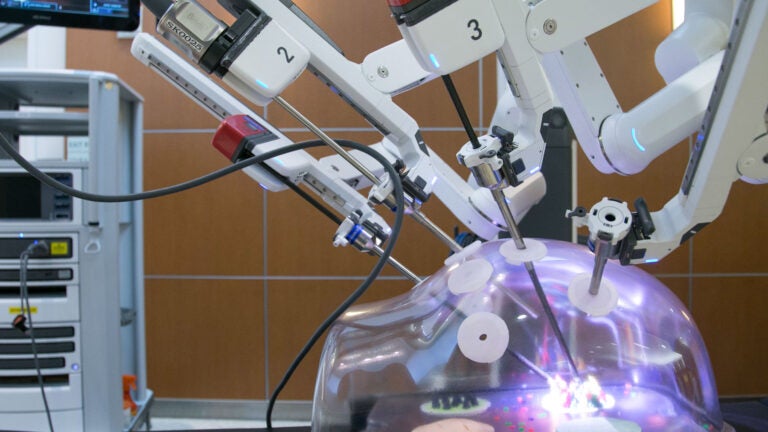
A demonstration of robotic urologic surgery takes place at USC. (Photo/Richard Carrasco III)
Patients with early kidney cancer see benefits from partial organ removal
Keck School of Medicine study may help urologists settle on the best surgical approach to the procedure
For patients with early kidney cancer, removing part of the kidney instead of the whole kidney is often a preferred treatment because the procedure can effectively remove tumors while preserving kidney function. But when it comes to the best surgical approach — robotic, laparoscopic or open — for this type of surgery, known as partial nephrectomy, the choice has been less clear. A comprehensive study by the Keck School of Medicine of USC, which has found that robotic partial nephrectomy offers significantly better patient outcomes, may help inform those decisions.
Our goal with this study was to critically evaluate the impact of three techniques on patient outcomes such as complications, cancer recurrence and mortality.
Inderbir Gill
“Robotic partial nephrectomy has become increasingly more common, yet there’s a lack of consensus among urologists about its performance vis-a-vis open or laparoscopic techniques,” said the study’s corresponding author Inderbir Gill, chair and Distinguished Professor of Urology at the Keck School of Medicine. “Our goal with this study was to critically evaluate the impact of these three techniques on patient outcomes such as complications, cancer recurrence and mortality.”
The systematic review and meta-analysis, published in the August issue of The Journal of Urology, combined data from 98 studies on robotic, open and laparoscopic partial nephrectomy. More than 20,000 patients were included in the analysis.
Kidney cancer outcomes
When comparing robotic to open partial nephrectomy, the study found that robotic partial nephrectomy offered several superior patient outcomes, including decreased complications during and after surgery, cancer recurrence, overall mortality, hospital length of stay and readmission. There was no difference in cancer-specific mortality between the two techniques.
Results also showed that robotic partial nephrectomy was equivalent to, and sometimes better than, laparoscopic partial nephrectomy. While there was no difference in cancer recurrence, cancer-specific mortality, length of hospital stay or readmission, a robotic technique was associated with lower overall mortality and fewer complications during and after surgery.
Gill, executive director of the USC Institute of Urology at Keck Medicine of USC, believes the data suggest that the technique of robotic partial nephrectomy has now become established in the field.
“Our study shows that robotic partial nephrectomy is not only safe and effective but also a preferred approach for treating small kidney tumors,” he said.
Kidney cancer is among the 10 most common cancers, affecting 1 in 48 men and 1 in 83 women. According to the American Cancer Society, the rate of kidney cancer has been rising since the 1990s, but the mortality rate has decreased slightly since then. The society predicts that about 63,000 Americans will be diagnosed with kidney cancer this year.



